Quetico August 2008
by Ho Ho
Day 9 (August 23, 2008): Campsite - Crooked Lake - Portage (Lower Basswood Falls) - Basswood River - Horse River - Portage - Horse River - Portage - Horse River - Lined Rapids - Horse River - Portage - Horse River - Lined Rapids - Horse River - Lined Rapids - Horse River - Lined Rapids - Horse River - Horse Lake - Portage - Tin Can Mike Lake - Portage - Sandpit Lake - Billygoat Portage - Mudro Lake - Portage - The Adventure Ends - about 13 miles altogether: 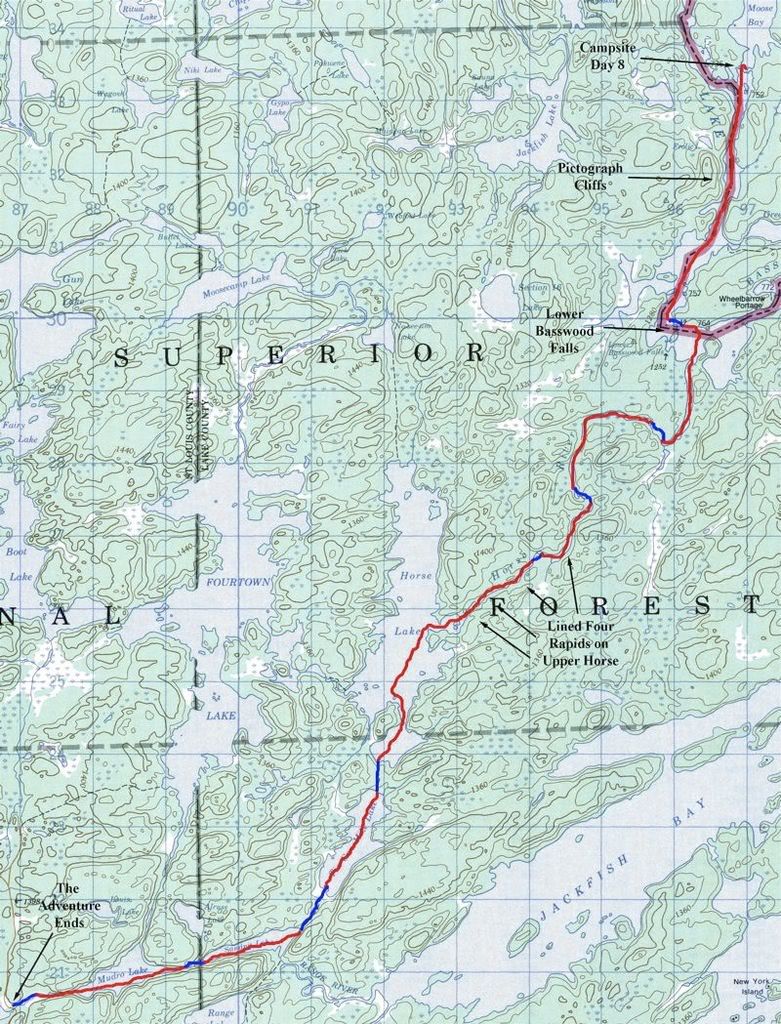
All good things must come to an end. Our trip wasn't over yet, though. We had some serious paddling and portaging through beautiful country left to go.
We had to get up before dawn to make it to Mudro by 2:00 in the afternoon, when we told my sister we would meet her there. The evening before we sat down with the map to estimate how long it would take us. We figured 20 minutes a mile for paddling, 1 minute for every 10 rods of portaging, plus 5 minutes of unloading and loading for each portage. Then we added an extra hour for everything else, like stopping for a snack and lining through rapids on the Horse River. We reorganized our gear into two packs instead of three so we could single portage to keep to our schedule.
We set the alarm on my watch for 5:30 a.m. and started our day in the pitch dark. At 6:30, while we were still making breakfast and breaking camp, we heard the two guys with the dog on the nearby American island load up their canoe and paddle away. I'm no advocate of ignoring the BW rules and camping away from designated sites. But I still had to admire their speedy commando style.
As for us, we got on the water a few minutes after our target of 7:30. Clouds had moved in again overnight, and the south headwind was still blowing. So much for my premature idea that this was the "trip of favorable winds."
We passed the occupied BW campsite we could see last night about a mile south of our own site, then came to the pictograph cliffs - 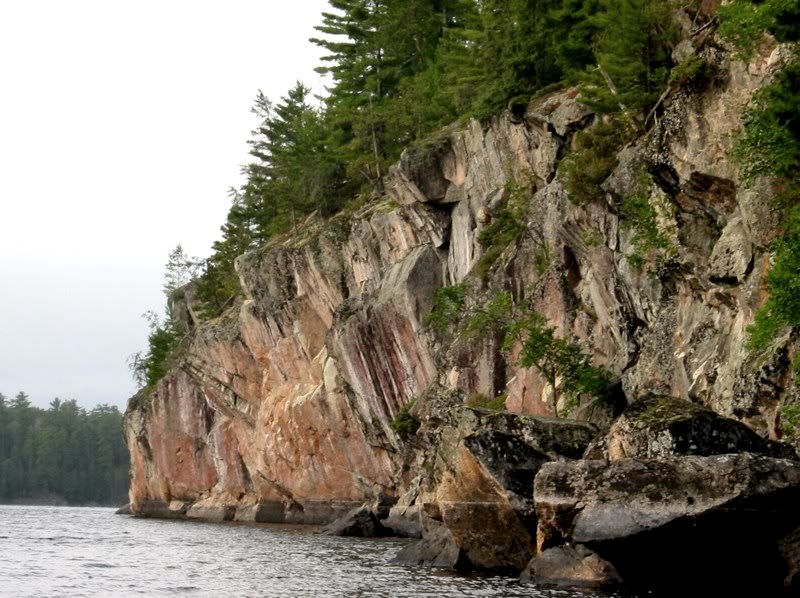
We coursed slowly by the pictographs. We didn't stop for photos (we took a lot here on our April/May 2006 trip). Then we continued paddling into the wind to Lower Basswood Falls. There were a couple people on the American shore there, but otherwise I was still surprised by how few people we were seeing in this area. I was kind of hoping we would run into our buddy Chuck, the guy we gave a ride from the Duluth airport to Ely the day before we started our trip. His group was planning on coming out at Mudro today too. But I think maybe they were going to try to go all the way out from Thursday or Friday Bay in a single day. If so, they were going to have a very tough day of fighting the south wind.
Portaging around Lower Basswood Falls was the first test of our efforts at speedy single portaging. Normally we unload stuff to shore and then hoist it for carrying, but today we were hoisting directly from the canoe while it was still in the water. First I put on the "smaller" pack, then helped David hoist the super-big-pig, then grabbed the canoe and we were off. I recalled from our last trip through here that the falls create a wind tunnel that makes it hard to carry the canoe as you walk along the precipice just above the rushing torrent. So it was now. You feel like at any moment, a gust could grab the canoe, twist it around, and send you flying into the crushing whitewater churning through the canyon below. But that just enhances the wonder of the experience. In any competition for my favorite portage, this would be high on the list.
We didn't factor in any time to take pictures along portages today, and this was another place we photographed a lot in April/May 2006, so I just put the canoe down in the water, we dropped the packs in, and we were off. Given the wind and the current, we made sure to paddle east along the shore till we were well away from the falls before turning north to cross the wide part of the Basswood River.
We were leaving the border and Canada behind and heading back into the United States via the Horse River. The channel at the mouth of the Horse was a little hard to find with all the emergent vegetation - 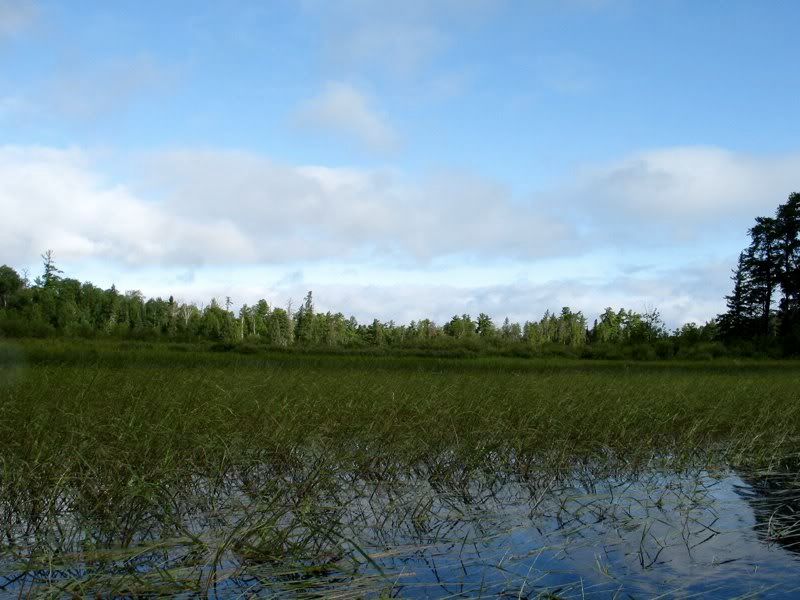
I've heard that the lower Horse River sometimes gets so shallow in late summer that it's just a mucky mess. Fortunately for us, when we found the channel it had several feet of water and was easy to follow. The hard part was that the headwind just kept blowing, even in the river. In this picture you can see that we were wearing more clothes than in days past because of the cold wind - 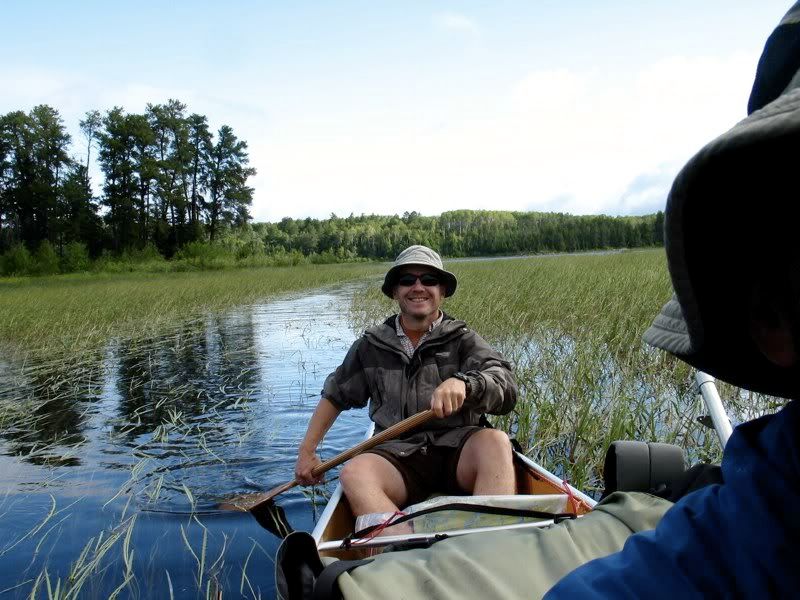
I really like the Horse River. There are three portages and, depending on water levels, several other spots where you have to portage, line, or paddle through rocky rapids. We lined through four of these areas, using the painters to guide the canoe upstream through fast water as we hopped from boulder to boulder or did a little wading. Here's a random spot along the river - 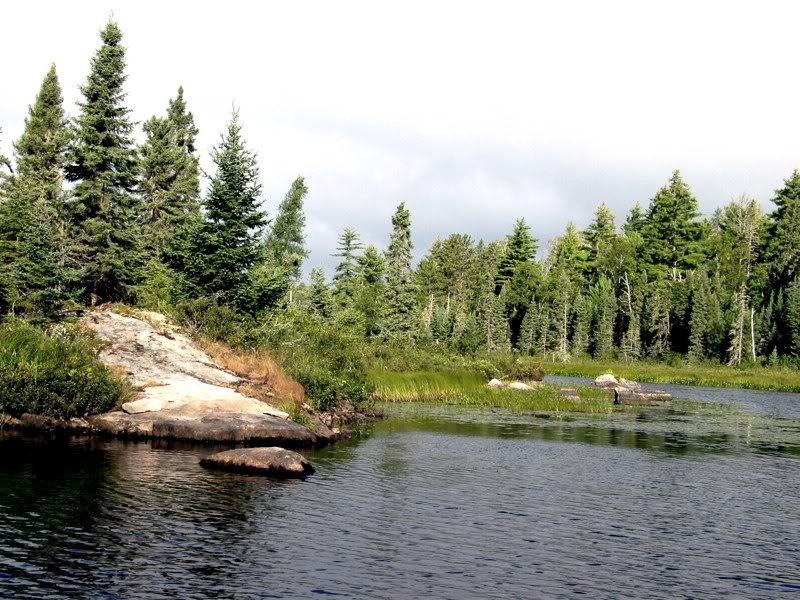
There were a lot of these flowers along the river's edge. Our first attempts to photograph them failed because they were swaying too much in the wind. Eventually we found a sheltered spot where they stood relatively still - 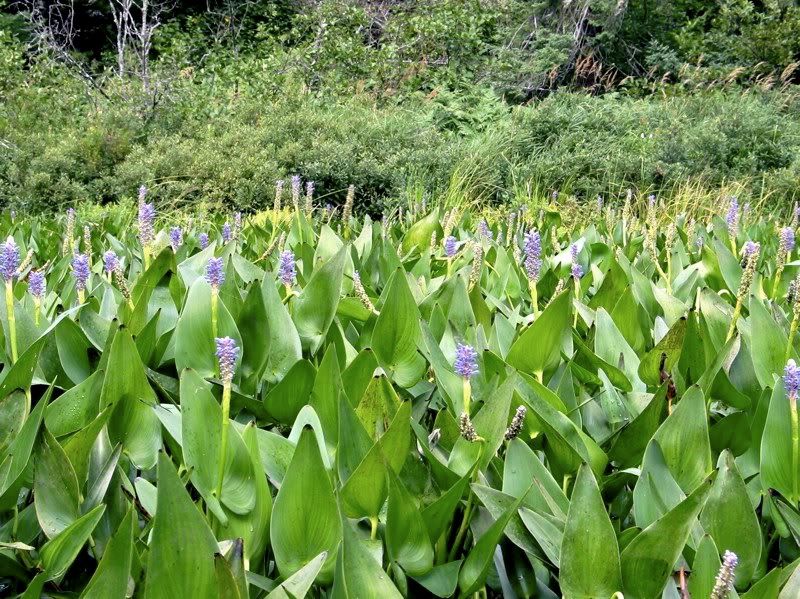
We saw no one else along the Horse River until just below the last rapids before Horse Lake, where a father-and-son team was paddling downstream. They didn't have gear in the canoe, so we figured they were exploring from a campsite on the lake. Just after we passed them, we came to the last rapids on the river and prepared to line the canoe upstream - 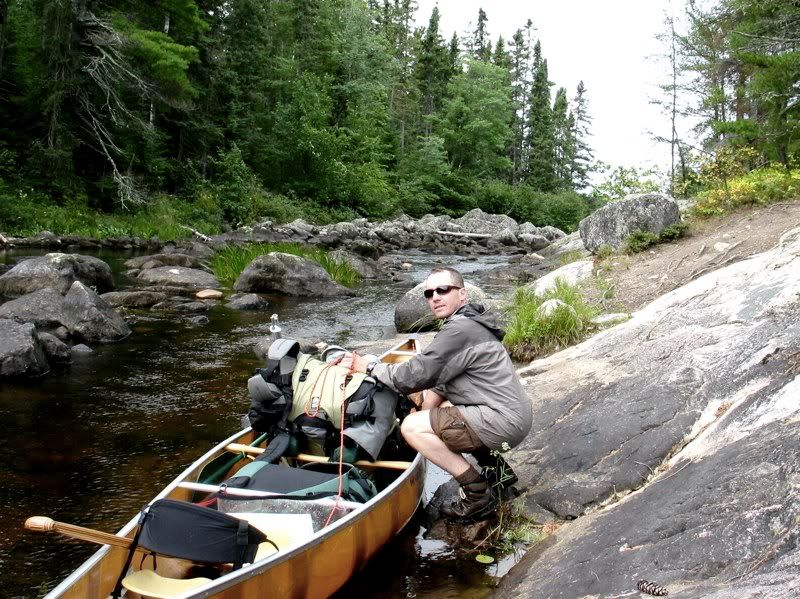
After those rapids, we soon came to Horse Lake. As we expected, the whitecaps were really rolling up the main part of the lake. We donned our PFDs and headed across, aiming at an angle for the shelter of the broad southwest point, before going through the narrows into the south bay whence begins the portage to Tin Can Mike. There was not one other canoe out on the lake. But there were plenty of people hunkered down in campsites.
More people were on the portage from Horse Lake to Tin Can Mike. We made the carry and paused at the Tin Can Mike end. There we chatted with a woman who was coming back for some more gear. She had a southern drawl and was dressed a little too nicely for the Boundary Waters. She asked where we had been and we told her, and she said this was her first trip and she was not entirely sure where her group was headed, but she was having a good time and ready for anything. Since conditions were less than ideal, I admired her attitude and thought she would have a great trip. Here I am at the Tin Can Mike landing before we shoved off (a canoe belong to the woman's group is in the background) - 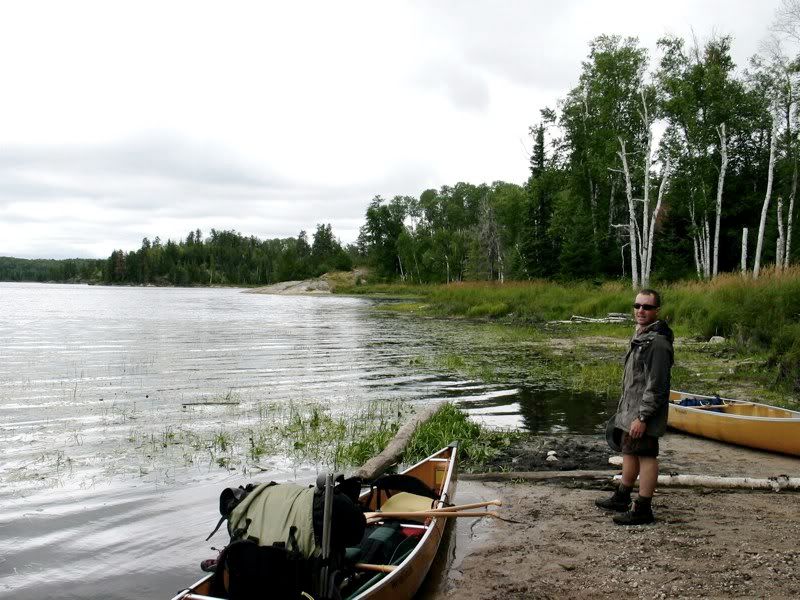
More groups were hunkered down at the campsites on Tin Can Mike, but again there were no other canoes on the lake. The headwind was still blowing fiercely, but the waves weren't as bad as on Horse due to the smaller size and the shape of Tin Can Mike.
When we got to the portage to Sandpit we paused to snack on some trail mix. An older husband and wife were portaging in the other way and we talked to them a bit. He was eyeing our Kevlar canoe with a bit of envy. Then we got ready to cross the portage, taking pictures of us with our single-carry loads. David with the super-big-pig - 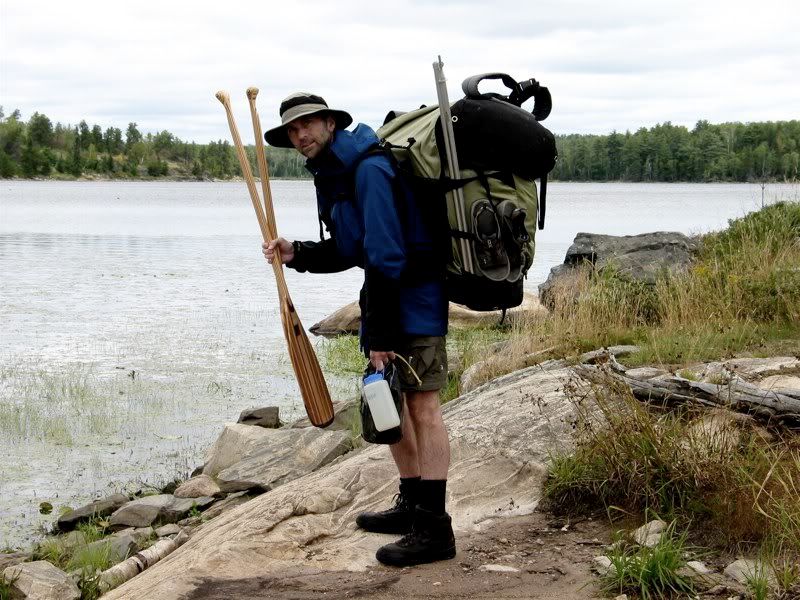
Me with pack and canoe - 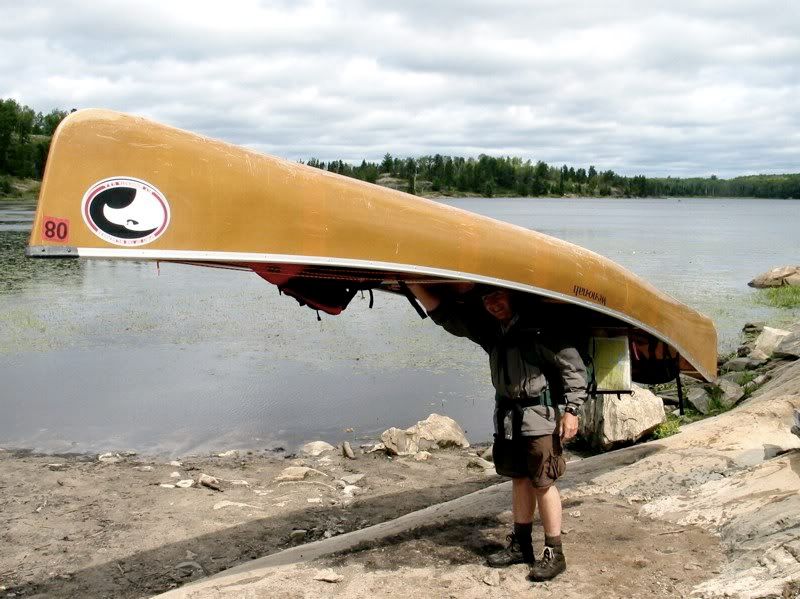
The portage from Tin Can Mike to Sandpit is a half mile long, but it follows an easy and level old railroad grade, so we cruised over it. Out on Sandpit Lake, there were plenty of whitecaps, despite the lake's small size and east-west orientation. We followed the more sheltered south shore to the billygoat portage to Mudro.
I knew this portage was steep. But I forgot it was so much steeper going uphill in this direction than the other way. It was a great final challenge single portaging up the hill at a steady stride. Most of our friends wonder why we like to do stuff like this for a vacation, but to me it's obvious. It's great to be alive, and to feel it. You don't get that lying on a beach.
More groups were loading up going in both directions at both ends of this portage, just like at the others since we hit Horse Lake. It surprised me that not one other person on all these portages - not one - ever put his or her feet in the water while loading or unloading their canoes. Life in canoe country is so much easier when you embrace the fact that your feet are supposed to be wet.
Out on Mudro there were plenty more whitecaps. As we paddled down the lake, a virtual armada converged from Fourtown and Sandpit, heading for the entry point. We almost had to get in line to paddle the last mile up Picket Creek. Then, before we knew it, we were at the final portage. We made our last carry to the old Chain Saw Sisters parking lot, which was filled with activity coming and going.
We got there at 1:45. Fifteen minutes later, right on schedule, Helen drove up with the dogs. We loaded up the car while Comet and Larson actively inspected the parking lot and portage. Then we were ready to go. As we drove away, I was struck by how strange and sad it is to be moved by a mechanical engine instead of paddling and portaging through the wilderness.
Next page . . . "Reflections."

 Donate - BWCA.com
Donate - BWCA.com